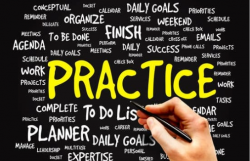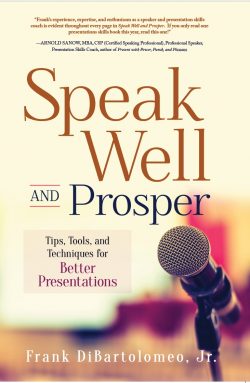Practice Doesn’t Make Perfect; It Makes Permanent

“If you don’t practice, you don’t deserve to win.”
– Andre Agassi, Legendary Tennis StarRemember when you were a kid, and your mom made you take piano, violin, or guitar lessons? Your music teacher told you to practice for a half hour each day to become good at the instrument.
Ok, fess up. Did you practice that half hour each day or use some lame excuse like you had homework and didn’t have the time to practice? It may have been the only time you used homework as an excuse to get out of an activity.
Let’s face it. Practicing an instrument is challenging for two reasons.
Number one, it is just plain hard to start to play an instrument, as any parent who has heard the wrong note played on the piano, the screeching of a violin, and a not-so-right twang on the guitar can attest.
Number two, we expect perfection when we begin to play an instrument. This is not possible. Only through years of practicing and playing can we and others enjoy our music.
So, what does this have to do with public speaking? How about everything!
Practicing is not just required to play an instrument well. You must practice to become a passible, excellent, and maybe outstanding speaker. The number of times you practice is directly proportional to the pace at which you improve your speaking ability.
Below is a three-step process for practicing your presentation:
Practice By Yourself Sitting Down
After you have prepared your speaking notes (This deserves a separate article in and of itself), practice your presentation sitting down. Record your voice if possible.
All presentations have an upper time limit. Always time yourself. It will become evident after you practice your presentation two or three times whether you have too much or too little material. Don’t make the mistake of just talking faster to stay under the time limit.
Constantly talking faster in a presentation will seem to the audience like the rapid firing of a machine gun. Speaking more quickly will also approach a monotone. Both of these will turn off the audience. If you exceed the time limit, your only solution is to take out material. The challenge is which material to take out.
As you speak, you will notice repeated words and verbal fillers such as “ah,” “um,” and “you know.” These will become even more obvious when you listen to the audio recording of your presentation. Write down the words you are repeating and your verbal fillers.
Verbal fillers are caused by your voice being ahead of your brain, thinking about what to say. If you are still thinking about what to say, it is much better to stop talking, determine what to say, and then start saying it rather than fill the time with repeated words, “ahs” and “ums.”
When you practice your presentation, be mindful of these speaking errors and try not to do them. This repeated practice of attempting to eliminate repeated words and verbal fillers will make you a better speaker. This step is necessary but insufficient because you cannot see your presentation as your audience does.
A simple way to do this is to deliver your presentation in front of a mirror.
Practice Standing Up in Front of a Mirror
Presentations are visual. Your audience takes cues from your body language. Therefore, it is essential to use the correct body language at the appropriate time at the point you are making in your presentation. Delivering your presentation in front of a mirror lets you see your body language in real-time. There is no hiding it.
During or right after your practice session in front of a mirror, jot down specific notes about your body language, choice of words, and the inflection you put on those words. See if they complement each other.
The name of my engineering school’s newspaper was “The Vector – With Magnitude and Direction.”
Vectors are simply forces in different directions that add to each other to form a composite vector. Just stick with me on this. There is a direct analogy to your speaking impact.
The maximum magnitude of the composite vector (spatial addition of two or more vectors) happens when the individual vectors are in the same direction. The composite vector will not be at its maximum magnitude if the vectors are not in the same direction.
Now, the analogy here is your body language, tone of voice, and the words you use are your “speaking vectors.” When they are aligned and supporting each other, it is like real vectors in the same direction producing the maximum magnitude of the “composite vector.”
You will see your “speaking vectors” in action when practicing your presentation in front of a mirror. Are your “speaking vectors” (i.e., your body language, tone of voice, actual words you use) in different directions, thus not producing your maximum “composite speaking vector” or impact? Or are they all aligned, in sync, and supporting each other to produce the maximum impact (greatest magnitude of your “composite speaking vector”)? Only you can decide.
We’ve explored practicing your presentation, sitting down, and then in front of a mirror. You might be able to guess what the next practicing process step is – speaking in front of a live practice audience.
Practice in Front of a Live Practice Audience
You have to go through the first two steps above before obtaining the maximum benefit from the third and final practice step – practicing in front of a live practice audience.
Practicing in front of a live practice audience is the closest you can get to the conditions of your actual presentation.
Brian Tracy says, “Practice doesn’t make perfect; it makes permanent.” So what great advantage does speaking in front of a live audience give you?
Be assured the way you deliver your presentation in front of a live practice audience is the way you will deliver your presentation when it comes time for the actual audience.
Your practice audience can consist of friends, colleagues, or relatives. It does not matter. What does matter is you need to emphatically request your practice audience to honestly tell you, without regard to your feelings, and in written form, the things you did well, the things you may want to work on, and the new things to try to make your presentation even better.
Dr. Ken Blanchard of One Minute Manager fame said, “Feedback is the breakfast of champions.” I want to be a champion at anything I do eventually. Since you have gotten this far in this article, I think you want to be a champion at anything you do, like delivering a presentation.
Delivering a presentation in front of a live audience makes it all real. The people in the audience are real, breathing, emotional human beings, just like you will have in the real audience for your presentation.
Again, if possible, have them take notes during your presentation in the three categories I previously mentioned – the things you did well, the things you may want to work on, and the new things to try to improve your presentation.
What your practice audience tells you will be a “gold mine” of feedback you are most likely to get from your real audience if you could.
Most speakers hand out an evaluation form to their audience after their presentation. Try this. Hand out your evaluation form before your presentation so your audience can evaluate you during your presentation. If you hand out evaluation forms before your presentation, you will find two things that happen – you will get more evaluations, and the quality of the evaluations you get will be “light-years” ahead of the evaluations you will get at the end of your presentation.
So, is there a process to practice your presentation? You bet there is.
Practice your presentation in this order: practice sitting down, in front of a mirror, and then speaking in front of a live practice audience.
The fastest way to become a passable, excellent, and outstanding speaker is to put your heart and soul into your presentation practice using these three steps.
It will pay you huge dividends when you deliver your presentation.
Practice does not make perfect, but it does make permanent!
Call to Action
For all future presentationsPractice sitting down
Practice in front of a mirror
Practice speaking in front of a live practice audience.
“Practice makes comfort. Expand your experiences regularly so every stretch won’t feel like your first.”
– Gina Greenlee, Author | Speaker | Teacher | CoachFrank DiBartolomeo is a retired U.S. Air Force Lieutenant Colonel and award-winning speaker, presentation and interview skills coach, and Professional Member of the National Speakers Association. He was awarded Toastmasters International’s highest individual award, Distinguished Toastmaster because of his outstanding work in public speaking and leadership.
Frank formed DiBartolomeo Consulting International (DCI), LLC (www.speakleadandsucceed.com) in 2007. The mission of DCI is to help technical professionals to inspire, motivate, and influence their colleagues and other technical professionals by improving their presentation skills, communication, and personal presence. Reach Frank at frank@speakleadandsucceed.com and (703) 509-4424.
Don’t miss Frank DiBartolomeo’s latest book!
“Speak Well and Prosper: Tips, Tools, and Techniques for Better Presentations”

Available now at Amazon.com and BarnesandNoble.com
